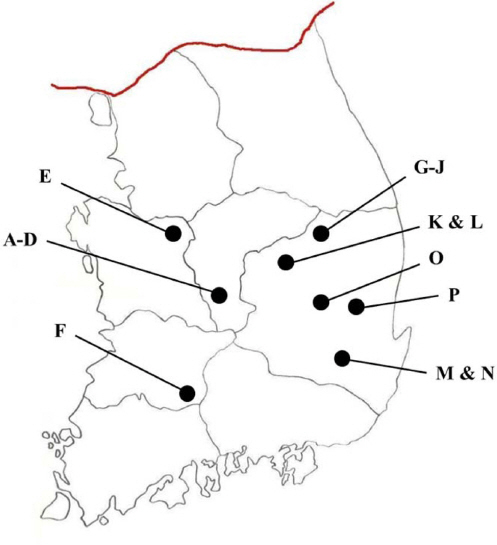Arai, S, Fukushima, C, Nakazawa, N and Segawa, K 1990. Susceptibility of apple root stock infected with apple chlorotic leaf spot virus to white root rot and violet root rot. Ann. Rept. Plant Prot. North Japan 41: 92-93.
Cambell, A and Sparks, T. R 1976. Experiments with dapple apple virus. Acta Hortic 67: 261-264.
Cho, I. S, Kim, D. H, Kim, J. R, Chung, B. N, Cho, J. D and Choi, G. S 2010. Occurrence of pome fruit viruses on pear trees (Pyrus pyrifolia) in Korea.
Res. Plant Dis 16: 326-330. (In Korean)

Han, J.-Y, Kim, J.-K, Cheong, J.-S, Seo, E.-Y, Park, C.-H, Ju, H.-K, Cho, I. S, Gotoh, T, Moon, J. S, Hammond, J and Lim, H.-S 2015. Survey of apple chlorotic leafspot virus and apple stem grooving virus occurrence in Korea and frequency of mixed infections in apple.
J. Fac. Agr. Kyushu Univ 60: 323-329.

Hassan, M, Myrta, A and Polak, J 2006. Simultaneous detection and identification of four pome fruit viruses by one-tube pentaplex RT-PCR.
J. Virol. Methods 133: 124-129.


Hong, K. H, Kim, Y. S, Kim, W. C, Kim, J. B, Lee, U. J, Lee, E. J, Cho, W. D and Cho, E. K 1985. Studies on the abnormal spot disease in pear leaf. Res. Rept. RDA (Hort.) 27: 46-55. (In Korean)
Kim, D. H, Kim, H. R, Heo, S, Kim, S. H, Kim, M. A, Shin, I. S, Kim, J. H, Cho, K. H and Hwang, J. H 2010. Occurrence of apple scar skin viroid and relative quantity analysis using real-time RT-PCR.
Res. Plant Dis 16: 247-253. (In Korean)

Kim, H. R, Kim, J. S, Hwang, J. H, Lee, S. H, Choi, G. S and Choi, Y. M 2004. Influence of ACLSV-infection on fruit quality of âHongroâ apples.
Res. Plant Dis 10: 145-149. (In Korean)

Kim, H. R, Heo, S, Shin, I.-S, Kim, J. H, Cho, K.-H and Kim, K. H 2009. Effects on apple tree growth and fruit quality by virus-infection. Kor. J. Hort. Sci. Technol 27(Suppl II):115. (In Korean)
Kim, H. R, Lee, S. H, Lee, D. H, Kim, J. S, Yun, K. O and Jang, H. I 2005. Transmission of apple scar skin viroid through grafting, seed and pruning scissors. Kor. J. Hort. Sci. Technol 23(Suppl I):42. (In Korean)
Kim, J. S, Lee, S. H, Choi, H. S, Kim, M. K, Kwak, H. R, Nam, K, Kim, J. S, Choi, G. S, Cho, J. D, Cho, I. S and Chung, B. N 2011. Occurrence of virus diseases on major crops in 2010.
Res. Plant Dis 17: 334-341. (In Korean)

Kinard, G, Scott, S and Barnett, O 1996. Detection of apple chlorotic leaf spot and apple stem grooving viruses using RT-PCR.
Plant Dis 80: 616-621.

Kwon, M. J, Hwang, S. L, Lee, S. J, Lee, D. H and Lee, J. Y 2002. Detection and distribution of apple scar skin viroid-Korean strain (ASSVd-K) from apples cultivated in Korea.
Plant Pathol. J 18: 342-344.

Lee, G, Kim, J. H, Kim, J. R, Shin, I. S, Cho, K. H, Kim, S. H, Shin, J and Kim, D. H 2013. Production system of virus-free apple plants using heat treatment and shoot tip culture.
Res. Plant Dis 19: 288-293. (In Korean)

Lee, J. H, Park, J. K, Lee, D. H, Uhm, J. Y, Ghim, S. Y and Lee, J. Y 2001. Occurrence of apple scar skin viroid-Korean strain (ASSVd- K) in apples cultivated in Korea. Plant Pathol. J 17: 300-304.
Liu, P, Zhang, L, Zhang, H, Jiao, H and Wu, Y 2013. Detection and molecular variability of Apple stem grooving virus in Shaanxi.
China. J. Phytopathol 161: 445-449.

Menzel, W, Jelkmann, W and Maiss, E 2002. Detection of four apple viruses by multiplex RT-PCR assays with coamplification of plant mRNA as internal control.
J. Virol. Methods 99: 81-92.


Millikan, D. F and Martin, W. R 1956. An unusual fruit dimple symptom in apple. Plant Dis. Rep 40: 229-230.
Nam, K. W and Kim, C. H 1994. Studies on the pear abnormal leaf spot disease 1. Occurrence and damage. Plant Pathol. J 10: 169-174. (In Korean)
Oh, S. D, Hong, S. B and Kim, Y. H 1973. Studies on virus disorder of top worked apple tree -II. On virus susceptibility of various apple rootstocks and on their symptoms. Kor. J. Hort. Sci. Technol 14: 1-6. (In Korean)
Ohtsuka, Y 1938. On Manshu-sabika-byo of apple, graft transmission and symptom variation in cultivars. J. Jpn. Soc. Hortic. Sci 9: 282-286.
Park, H. L, Yoon, J. E, Kim, H. R and Baek, K. H 2006. Multiplex RTPCR assay for the detection of Apple stem grooving virus and Apple chlorotic leaf spot virus in infected Korean apple cultivars.
Plant Pathol. J 22: 168-173.

Smith, P. R and Challen, D. I 1972. Aetiology of the rosette and decline diseases of peach and interactions between Prunus necrotic ringspot, Prune dwarf, and dark green sunken mottle viruses.
Austr. J. Agric. Res 23: 1027-1034.

The Korean Society of Plant Pathology. 2009. List of Plant Diseases in Korea. 5th ed pp. 184-195.
Wood, G. A 1979. Virus and Virus-Like Diseases of Pome Fruits And Stone Fruits in New Zealand No. 226. Bulletin, Department of Scientific and Industrial Research, Wellington. pp. 87 pp.




 PDF Links
PDF Links PubReader
PubReader Full text via DOI
Full text via DOI Download Citation
Download Citation Print
Print






